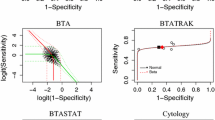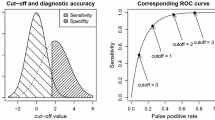Abstract
Meta-analysis of diagnostic studies experience the common problem that different studies might not be comparable since they have been using a different cut-off value for the continuous or ordered categorical diagnostic test value defining different regions for which the diagnostic test is defined to be positive. Hence specificities and sensitivities arising from different studies might vary just because the underlying cut-off value had been different. To cope with the cut-off value problem interest is usually directed towards the receiver operating characteristic (ROC) curve which consists of pairs of sensitivities and false-positive rates (1-specificity). In the context of meta-analysis one pair represents one study and the associated diagram is called an SROC curve where the S stands for “summary”. In meta-analysis of diagnostic studies emphasis has traditionally been placed on modelling this SROC curve with the intention of providing a summary measure of the diagnostic accuracy by means of an estimate of the summary ROC curve. Here, we focus instead on finding sub-groups or components in the data representing different diagnostic accuracies. The paper will consider modelling SROC curves with the Lehmann family which is characterised by one parameter only. Each single study can be represented by a specific value of that parameter. Hence we focus on the distribution of these parameter estimates and suggest modelling a potential heterogeneous or cluster structure by a mixture of specifically parameterised normal densities. We point out that this mixture is completely nonparametric and the associated mixture likelihood is well-defined and globally bounded. We use the theory and algorithms of nonparametric mixture likelihood estimation to identify a potential cluster structure in the diagnostic accuracies of the collection of studies to be analysed. Several meta-analytic applications on diagnostic studies, including AUDIT and AUDIT-C for detection of unhealthy alcohol use, the mini-mental state examination for cognitive disorders, as well as diagnostic accuracy inspection data on metal fatigue of aircraft spare parts, are discussed to illustrate the methodology.
Similar content being viewed by others
References
Aergeerts, B., Buntinx, F., & Kester, A. (2004). The value of the CAGE in screening for alcohol abuse and alcohol dependence in general clinical populations: A diagnostic meta-analysis. Journal of Clinical Epidemiology, 57, 30–39.
Aitkin, M. (1999a). A general maximum likelihood analysis of variance components in generalized linear models. Biometrics, 55, 117–128.
Aitkin, M. (1999b). Meta-analysis by random effect modelling in generalized linear models. Statistics in Medicine, 18, 2343–2351.
Biggerstaff, B.J., & Tweedie, R.L. (1997). Incorporating variability in estimates of heterogeneity in the random effects model in meta-analysis. Statistics in Medicine, 16, 753–768.
Böhning, D., Dietz, E., & Schlattmann, P. (1998). Recent developments in computer-assisted analysis of mixtures (C.A.MAN). Biometrics, 54, 367–377.
Böhning, D. (2000). Computer-assisted analysis of mixtures and applications. Meta-analysis, disease mapping and others. Boca Raton: Chapman & Hall/CRC.
Böhning, D., Malzahn, U., Dietz, E., Schlattmann, P., Viwatwongkasem, C., & Biggeri, A. (2002). Some general points in estimating heterogeneity variance with the DerSimonian–Laird estimator. Biostatistics, 3, 445–457.
Böhning, D. (2003). The EM algorithm with gradient function update for discrete mixtures with known (fixed) number of components. Statistics and Computing, 13, 257–265.
Böhning, D., & Viwatwongkasem, C. (2005). Revisiting proportion estimators. Statistical Methods in Medical Research, 14, 1–23.
Böhning, D., Holling, H., & Böhning, W. (2008). Revisiting Youden’s index as a useful measure of the misclassification error in meta-analysis of diagnostic studies. Statistical Methods in Medical Research, 17, 543–554.
Brockwell, S.E., & Gordon, I.R. (2001). A comparison of statistical methods for meta-analysis. Statistical Methods in Medical Research, 20, 825–840.
Clayton, D.G., & Kaldor, J. (1987). Empirical Bayes estimates of age-standardized relative risks for use in disese mapping. Biometrics, 43, 671–681.
Cooper, H., & Hedges, L. (1994). The handbook of research synthesis. New York: Russell Sage Foundation.
Dempster, A.P., Laird, N.M., & Rubin, D.B. (1977). Maximum likelihood estimation from incomplete data via the EM algorithm (with discussion). Journal of the Royal Statistical Society. Series B, 39, 1–38.
DerSimonian, R., & Laird, N. (1986). Meta-analysis in clinical trials. Controlled Clinical Trials, 7, 177–188.
Egger, M., Smith, G.D., & Altman, D.G. (2001). Systematic reviews in health care: Meta-analysis in context. London: BMJ Publishing Group.
Gatsonis, C., & Paliwal, P. (2006). Meta-analysis of diagnostic and screening test accuracy evaluations: Methodologic primer. American Journal of Roentgenology, 187, 271–281.
Harbord, R.M., Deeks, J.J., Egger, M., Whiting, P., & Sterne, J.A.C. (2007). A unification of models for meta-analysis of diagnostic accuracy studies. Biostatistics, 8, 239–251.
Hardy, R.J., & Thompson, S.G. (1996). A likelihood approach to meta-analysis with random effects. Statistics in Medicine, 15, 619–629.
Hardy, R.J., & Thompson, S.G. (1998). Detecting and describing heterogeneity in meta-analysis. Statistics in Medicine, 17, 841–856.
Hasselblad, V., & Hedges, L.V. (1995). Meta-analysis of screening and diagnostic tests. Psychological Bulletin, 117, 167–178.
Hedges, L.V., & Olkin, I. (1985). Statistical methods for meta-analysis. New York: Academic Press.
Hunter, J.E., Schmidt, F.L., & Jackson, B.G. (1982). Meta-analysis: Cumulative research findings across studies. Beverly Hills: Sage Publications.
Irwig, L., Tosteson, A.N., Gatsonis, C., Lau, J., Colditz, G., Chalmers, T.C., & Mosteller, F. (1994). Guidelines for meta-analyses evaluating diagnostic tests. Annals of Internal Medicine, 120, 667–676.
Irwig, L., Macaskill, P., Glasziou, P., & Fahey, M. (1995). Meta-analytic methods for diagnostic test accuracy. Journal of Clinical Epidemiology, 48, 119–130.
Kiefer, J., & Wolfowitz, J. (1956). Consistency of the maximum likelihood estimator in the presence of infinitely many incidental parameters. Annals of Mathematical Statistics, 27, 886–906.
Kriston, L., Hölzel, L., Weiser, A., Berner, M.M., & Härter, M. (2008). Meta-analysis: Are 3 questions enough to detect unhealthy alcohol use? Annals of Internal Medicine, 149, 879–888.
Kuhnert, R., & Böhning, D. (2007). A comparison of three different models for estimating relative risk in meta-analysis. Statistics in Medicine, 28, 2277–2296.
Laird, N.M. (1978). Nonparametric maximum likelihood estimation of a mixing distribution. Journal of the American Statistical Association, 73, 805–811.
Le, C.T. (2006). A solution for the most basic optimization problem associated with an ROC curve. Statistical Methods in Medical Research, 15, 571–584.
Lindsay, B.G. (1983). The geometry of mixture likelihoods: A general theory. Annals of Statistics, 11, 86–94.
Lindsay, B.G. (1995). Mixture models: Theory, geometry, and applications. Hayward: Institute of Statistical Mathematics.
Macaskill, P., Glasziou, P., & Irwig, L. (2005). Meta-analysis of diagnostic tests. In P. Armitage & T. Colton (Eds.), Encyclopedia of biostatistics. doi:10.1002/0470011815.b2a04026.
Martin, C.S., Liepman, M.R., & Young, C.M. (1990). The Michigan alcoholism screening test: False positives in a college student sample. Alcoholism, Clinical and Experimental Research, 14, 853–855.
McCullagh, P., & Nelder, J.A. (1989). Generalized linear models. London: Chapman & Hall.
McLachlan, G., & Peel, D. (2000). Finite mixture models. New York: Wiley.
Midgette, A.S., Stukel, T.A., & Littenberg, B. (1993). A meta-analytic method for summarizing diagnostic test performances: Receiver-operating-characteristic-summary point estimates. Medical Decision Making, 13, 253–257.
Mitchell, A.J. (2009). A meta-analysis of the accuracy of the mini-mental state examination in the detection of dementia and mild cognitive impairment. Journal of Psychiatric Research, 43, 411–431.
Moses, L.E., Littenberg, B., & Shapiro, D. (1993). Combining independent studies of a diagnostic test into a summary ROC curve: Data-analytical approaches and some additional considerations. Statistics in Medicine, 12, 1293–1316.
Ray, S., & Lindsay, B.G. (2008). Model selection in high dimensions: A quadratic-risk-based approach. Journal of the Royal Statistical Society. Series B, 70, 95–118.
Rabe-Hesketh, S., Pickles, A., & Skrondal, A. (2003). Correcting for covariate measurement error in logistic regression using nonparametric maximum likelihood estimation. Statistical Modelling, 3, 215–232.
Reinert, D.F., & Allen, J.P. (2002). The alcohol use identification test (AUDIT): A review of recent research. Alcoholism, Clinical and Experimental Research, 26, 272–279.
Reitsma, J.B., Glas, A.S., Rutjes, A.W.S., Scholten, R.J.P.M., Bossuyt, P.M., & Zwinderman, A.H. (2005). Bivariate analysis of sensitivity and specificity produces informative measures in diagnostic reviews. Journal of Clinical Epidemiology, 58, 982–990.
Ross, S. (1985). Introduction to probability models. Orlando: Academic Press.
Rutter, C.M., & Gatsonis, C.A. (2001). A hierarchical regression approach to meta-analysis of diagnostic test accuracy evaluations. Statistics in Medicine, 20, 2865–2884.
Schulze, R., Holling, H., & Böhning, D. (Eds.) (2003). Meta-analysis. New developments and applications in medical and social sciences. Göttingen: Hogrefe & Huber.
Selzer, M.L. (1971). The Michigan alcoholism screening test: The quest for a new diagnostic instrument. American Journal of Psychiatry, 127, 1653–1658.
Sidik, K., & Jonkman, J.N. (2005). Simple heterogeneity variance estimation for meta-analysis. Journal of the Royal Statistical Society. Series C, 54, 367–384.
Skrondal, A., & Rabe-Hesketh, S. (2004). Generalized latent variable modeling: Multilevel, longitudinal, and structural equation models. Boca Raton: Chapman & Hall/CRC.
Storgaard, H., Nielsen, S.D., & Gluud, C. (1994). The validity of the Michigan alcoholism screening test (MAST). Alcohol and Alcoholism, 29, 493–502.
Sutton, A.J., Abrams, K.R., Jones, D.R., Sheldon, T.A., & Song, F. (2000). Methods for meta-analysis in medical research. New York: Wiley.
Sweeting, M.J., Sutton, A.J., & Lambert, P.C. (2004). What to add to nothing? Use and avoidance of continuity corrections in meta-analysis of sparse data. Statistics in Medicine, 23, 1351–1375.
Swets, J.A. (2009). Signal detection theory and ROC analysis in psychology and diagnostics. New York: Psychology Press.
van Houwelingen, H.C., Zwinderman, K.H., & Stijnen, T. (1993). A bivariate approach to meta-analysis. Statistics in Medicine, 12, 2273–2284.
Whitehead, A. (2002). Meta-analysis of controlled clinical trials. New York: Wiley.
Author information
Authors and Affiliations
Corresponding author
Rights and permissions
About this article
Cite this article
Holling, H., Böhning, W. & Böhning, D. Likelihood-Based Clustering of Meta-Analytic SROC Curves. Psychometrika 77, 106–126 (2012). https://doi.org/10.1007/s11336-011-9236-2
Received:
Revised:
Published:
Issue Date:
DOI: https://doi.org/10.1007/s11336-011-9236-2




